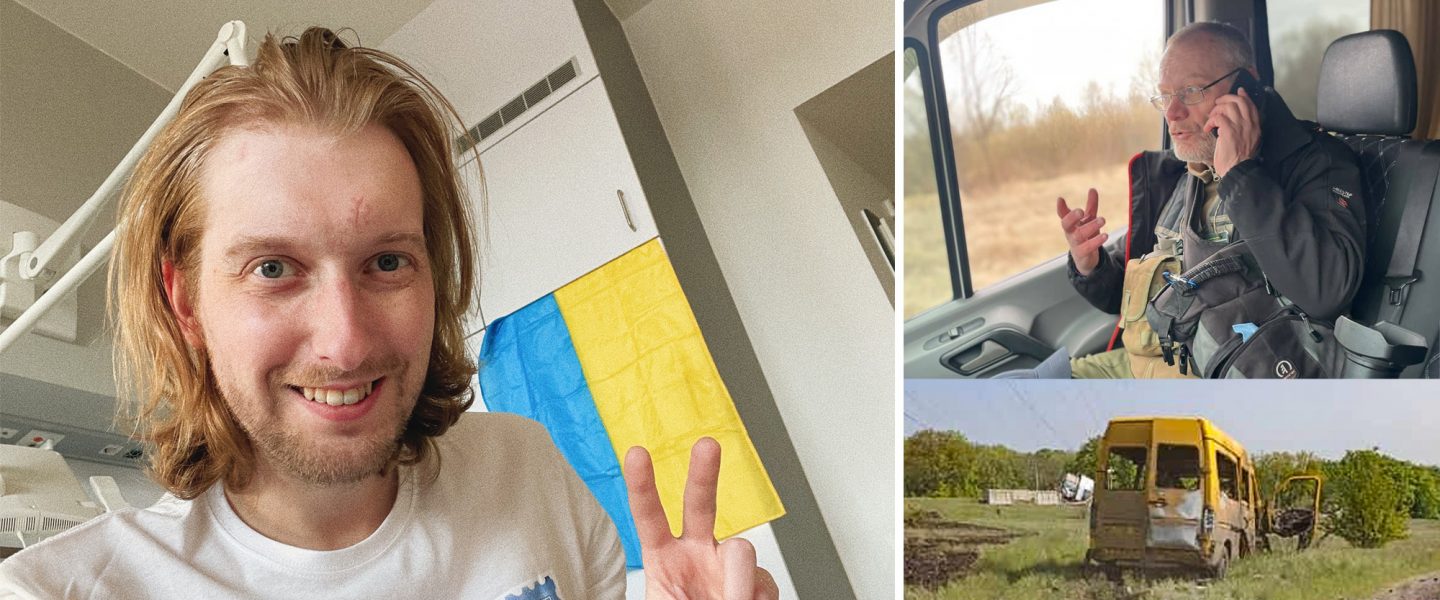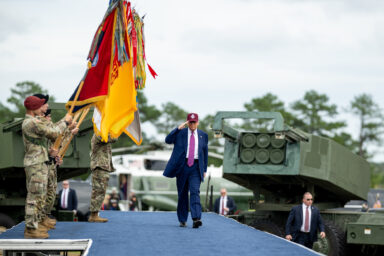A civilian fleet of thousands of cars and drivers is delivering badly needed food, fuel, and medicine to Ukrainian cities and far-flung villages — at a great cost.
On May 7, Sergii Gimiush was riding in a microbus full of food and diapers, careening along a road near Kharkiv towards Ukrainian villages at risk of famine. The next thing he knew, he was crawling across a dirt road with a broken jaw and two broken legs, trying to avoid Russian artillery fire.
Gimiush is one of countless Ukrainians who, despite not taking up arms, have nonetheless joined the war effort as the fighting in Ukraine enters its fourth month.
In his case, before he was grievously wounded on May 7, he was one of at least 12,000 volunteer drivers who, since the February 24 invasion, have driven thousands of personal vehicles across the country. These vehicles serve to evacuate refugees and deliver tons of humanitarian cargo, according to Yarsolav Boiko, the head of Everything Will Be Fine, which coordinates the volunteer efforts of 187 organizations in Ukraine, including 56 in the contested Donetsk and Luhansk regions.
A mishmash of about 1,000 organizations is keeping this internal supply chain running, shuttling fuel and food to isolated villages where conventional supply lines have broken down, and ferrying stranded civilians to safety. While the volunteer drivers can receive some assistance — sometimes from the various organizations or from the Ukrainian government — this network is mostly pure grassroots: an ad-hoc effort using personal vehicles and personal funds.
Driving supplies through a warzone is extremely risky. Many have paid a high price — sometimes with their own lives. Of the three volunteers riding in the microbus struck by a missile on May 7, Gimiush was the worst off.
On June 7, one month to the day since the attack, Gimiush wrote to me from a hospital in Germany. His right leg had just been amputated, following the earlier amputation of his left foot. He spoke about the future with restrained optimism.
“I am sure that we will win, but it will take time and a lot of good people,” Gimiush texted. His broken jaw makes it difficult to speak.

Accurate statistics are impossible to compile during wartime. But according to Boiko, despite the fact that firing on civilians is a war crime, six out of the 60 drivers on Everything Will Be Fine’s roster have been killed: two at the Kramatorsk Railway Station, two in Mariupol, one in Rubizhne, and one in Severodonetsk.
“There are cases when buses come under fire in hot spots — Berestove, Popasnaya, Vuhledar, Soledar, and other cities in which it is now very hot,” Boiko said.
Despite the risks, the supply runs continue. In some cases, they represent the only lifeline. While international aid organizations like the Red Cross sometimes have success with supply runs or evacuations, they do not enter areas where they’re unable to get safety guarantees from both sides.

The southern city of Mykolaiv relies on the work of supply drivers. Mykolaiv was cut off from water in mid-April, when Russian troops blew up the Dnipro-Mykolaiv water pipeline. Now, twice a day, Mykolaiv residents line up to get water delivered in trucks from Odesans.
When supplies don’t get through, the result is what happened in Mariupol, where at least some of the perhaps 22,000 civilians who have died since February 24 are thought to have starved to death.

Before the war, Gimiush, a 30-year-old economics grad, was living with his parents not far from Kyiv’s central train station. He worked on military export contracts for the Ukrainian government. In his free time, he played soccer two to three times a week, alternating between goalie and defender.
The day the war began, Gimiush helped his parents pack for Moldova, but didn’t consider leaving himself, positive Kyiv would withstand Russia’s attack.
Meanwhile, another Kyivan, Yevhenii Skyba, 36, was training to be a project manager for an American-based IT company hiring Ukrainian programmers and managers.
In early March, Skyba and some friends, with help from an acquaintance’s company, bought a Jeep Patriot together and used it to do supply runs in Kyiv. He guesses he’s completed at least 70. Over the past three weeks, Skyba and the Patriot have gone through about 1,000 liters (~264 gallons) of gasoline. Half the time, he gets help buying gas from organizations he’s working with. The rest, he pays for out of pocket.
“Volunteering is now my life,” he told me via Telegram.
Not all of the volunteer organizations are credible. Skyba believes some charities “make money like financial pyramids.”
So he usually divides up his labor among three organizations he’s had positive experiences with and trusts: Trinity Fund, which was started before the war and provides humanitarian aid, medical equipment, and evacuations; Giznelub, which was originally focused on helping the elderly and has expanded to provide humanitarian aid and evacuations for all ages; and Suviato, which is focused on helping active military and veterans.
When the war started, Skyba was one of about 20 people who moved into a local basement-level bar that served as a bomb shelter. The bar also became a supplies warehouse.
Skyba and Gimiush met there and began working together, with Skyba doing a lot of the route planning, navigating, and recruiting of vehicles and other volunteers.

Over the next month and a half, Gimiush drove about 1,200 miles back and forth just within Kyiv, delivering everything from diapers to pickled beets — requests he got mostly from private Telegram groups.
“Every day I had 3-5 addresses where to pick something up or give something to someone,” he wrote. “The first days I was afraid — then no.”
At the beginning of April, when Russian forces retreated from around Kyiv to the east, he started making runs outside of the city and into the Kyiv and Chernihiv regions, or “oblasts.”
Along with formerly occupied Kyiv suburbs, Gimiush went to tiny villages, and even scattered houses in the Chernobyl exclusion zone inhabited by old ladies who defied Soviet authorities and returned to their homes shortly after the 1986 nuclear disaster, and have since refused to stay out.

But Gimiush knew that the urgency for help in the east was the greatest — and also the most dangerous.
So on May 6, Gimiush and Skyba headed out for their first delivery there, beyond Kharkiv, to villages near the frontline.
They coordinated with the Ukrainian military on this trip, to take — at least what they thought was to be — a safer route. Along with 11 volunteers, there were also three Ukrainian soldiers, including the driver of Skyba’s microbus.
When they made it to the tree, it was clear that Fedfedenko only had some scratches and bruises, but the legs of both Gimiush and Tumasov were broken.
Their two microbuses were loaded with goods for four villages near the frontline: clothing, diapers for babies and adults, sugar, toys, canned food, toilet paper, water, and a generator for a farmer.
They had spent the previous night sleeping in the Ukrainian Literature room of a school in Andriivka, a village in the Kharkiv region, located about 7 miles from the frontline.
Gimiush rode with driver Taras Fedfedenko in the second microbus. They were joined by international landscape photographer Sergiy Tumasov, 57, who snapped a photo of Gimiush just before they hit the road.

“On this photo I’m smiling and still touching the ground with both of my legs. In five minutes, I’m going to take my seat in the car, and in one hour, my life would split into ‘before’ and ‘after,’” Gimiush wrote in a June 3 Instagram post.
Not quite an hour into their trip, Skyba heard a very specific sound — almost like a motorboat. One of the soldiers traveling with him recognized the noise as a drone.
Neither Gimiush nor Tumasov heard it despite their shared silence for the majority of the ride.
At around 10:40 a.m. — just before the attack on the microbus, which the volunteers believe was hit by a 120mm mortar shell directed by the drone — they saw smoke in the distance and heard explosions. Stressed, the drivers accelerated.
“As a photographer, I thought: ‘How terrible and beautiful at the same time,’” remembered Tumasov, who raised his camera to take a picture right as the shell struck. “At that moment, the [shrapnel] hit the car. Shrapnel cut off the lens of my camera. It may have saved my life.”

Skyba’s driver floored the gas pedal and got clear. But Gimiush’s vehicle was on fire.
“It looked like ‘fuck, fuck, fuck.’ We need to stop and help but we need to move because we can be there, too,” Skyba said.
For Gimiush, who was sitting to Tumasov’s right, everything happened quickly and his vision went white.
“I could only hear whizzing in my ears. I couldn’t understand what had happened and lost consciousness for a few seconds. When I opened my eyes, I found myself lying on the ground [about 15 feet] from our demolished [microbus],” Gimiush said.

When Tumasov came to, he couldn’t feel his legs, which were trapped in metal. Despite fire all around, Fedfedenko carefully pulled him out of the microbus and carried him toward a tree on the side of the road.
Meanwhile, Gimiush started screaming and immediately felt his jaw. It was broken. He saw that his legs were twisted up in an unnatural position and felt like they were in hot water.
Eight to 10 more mortar shells landed, some as close as 15 feet away. On his own, while Fedfedenko was helping Tumasov, Gimiush ditched the camera that was still around his neck and managed to crawl approximately 25 yards to the tree.
When they made it there, it was clear that Fedfedenko only had some scratches and bruises, but the legs of both Gimiush and Tumasov were broken.
“They thought I was sleeping. I screamed some rude words and lost consciousness again.”
By the side of the tree, Gimiush couldn’t imagine dying. He thought instead about the plants in his apartment that he had to water. Tumasov worried about what he’d tell his wife while he tried to stop his bleeding using a stuffed animal intended to be delivered to a child.
Close to 40 minutes later, two Ukrainian soldiers came to investigate. They arrived none too soon, pulling the volunteers out just before the area was hit again, this time with Grad missiles. One of the soldiers kept Gimiush talking while he put a tourniquet on his leg, even as Gimiush started feeling cold and sleepy.
Gimiush has a memory of being in a corridor at a Kharkiv hospital, where he overheard an emergency medical technician tell a doctor about his foot amputation.
“They thought I was sleeping. I screamed some rude words and lost consciousness again.”
With a few stops in between and some help from Doctors Without Borders, Gimiush was transferred to Lübeck, Germany, where he’s now being treated at The University Medical Center Schleswig-Holstein.
Tumasov is back home in Kyiv, where he said his wife and two daughters are taking good care of him. He expects at least three more surgeries in addition to the six he’s already undergone — and eight to nine months of rehabilitation to follow.

Gimiush reminds himself that he’s glad to be alive and able to speak to people he cares about, like his sister — the last person he texted before he passed out.
As Gimiush understands, the German government has handled his medical expenses as part of an aid program that Germany is providing to besieged Ukraine.
“Doctors told me that people who lose so much blood mostly don’t survive,” Gimiush wrote on Instagram, “thus I realized that on the 7th of May I had more chances to die than survive, and the fact that I can move and breathe was already a big reason to be happy. So, truly, the 7th of May is my second birthday. With this thought in mind it became easier for me to overcome this situation, and this thought helps me till now.”
As for Skyba, he’s preparing for his next supply run.




